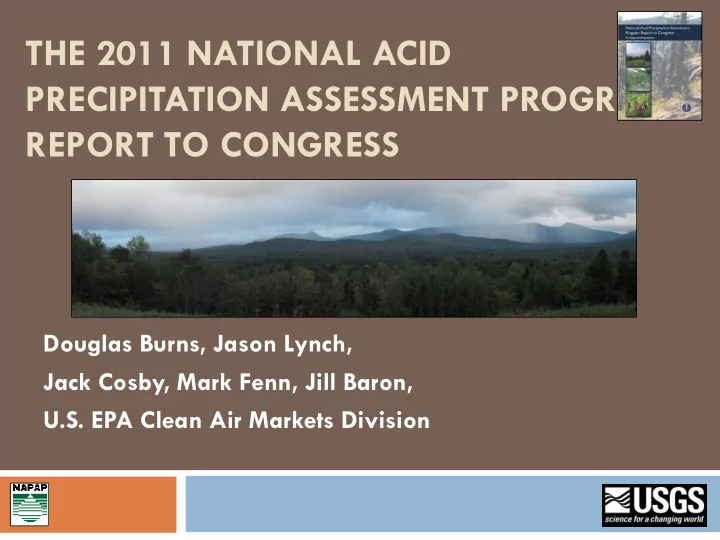

THE 2011 NATIONAL ACID PRECIPITATION ASSESSMENT PROGRAM REPORT TO CONGRESS Douglas Burns, Jason Lynch, Jack Cosby, Mark Fenn, Jill Baron, U.S. EPA Clean Air Markets Division
Status of Report Fifth NAPAP report(s) – previous in 2005 Through peer review and review by Air Quality Research Subcommittee of Committee for Environ., Natural Resour. and Sustainability Currently with Office of Science and Technology Policy for final review Hopeful of late 2011 publishing date
Content Executive Summary and Introduction Chapter 1 – Overview of Acid Rain Program, costs and benefits Chapter 2 – Trends emissions and deposition, critical loads Chapter 3 – State-of-science, ecosystem effects of acid deposition Chapter 4 – Modeling future ecosystem effects, emissions/deposition scenarios
Acid Rain Program (ARP) EPA program that implements Title IV 1990 Clean Air Act Amendments SO 2 – Cap-and-trade, 8.95 Mt cap by 2010 NO X – Traditional emissions control, averaging Human health benefits – $174 to $427 billion/yr in 2010, primarily PM2.5 and secondarily O 3 Costs – $1 to $3 billion/yr
Additional Benefits of ARP Ecological and visibility improvement benefits not well quantified Adirondack case study - Banzhaf et al., 2006, ecological benefits of $336 - $749 million/yr Recent EPA study - visibility benefits $40 billion/yr More research needed to better quantify complete set of benefits – ecosystem services
SO 2 Emissions 20 Title IV SO 2 Utility Emissions (millions tons/yr) 18 16 14 12 10 8 6 4 65% decline since 1994 2 0 1940 1950 1960 1970 1980 1990 2000 2010 Year
NO x Emissions 7 ARP NO x Emissions (millions tons/yr) 6 5 4 3 65% decline since 1995 2 1 1980 1990 2000 2010 Year
Air Quality – Ambient SO 2 1989-91 2007-09
Air Quality – Ambient NO 3 1989-91 2007-09
Wet Deposition 2- SO 4 40%+ decline since early 1990s
Wet Deposition Inorganic N 20% to 25% decline since early 1990s except mid-west + Role of NH 3 /NH 4
Ecosystem Recovery More complex and nuanced story Aquatic ecosystems 2- decreasing everywhere except SE SO 4 1. - decreases at many sites, but less than SO 4 2- and no NO 3 2. decreases at some sites ANC – increasing in NE, but not in SE 3. Terrestrial ecosystems – most studies show no recovery, continued declines in soil base saturation Little evidence to evaluate species recovery – limited evidence that aquatic ecosystems beginning to recover
Trends in lake and Stream Water Chemistry at LTM Sites , 1990 - 2008 , Sulfate lon Concentration (!leq/Uyr) • 0 1990-2008 Sulfate lon Concentration • • • Increasi ng significant trend o Increasing non-significant trend 0 Decreasing non-significant trend • Decreasing significant trend Source: EPA. 2010
~ Trends in lake and Stream Water Chemistry at LTM Sites, 1990·2008, Nitrate lon Concentration (peq/Uyr) • 0 199G-2008 Nit rate lon Concentration • • • Increasi ng significant trend o Increasi ng non-significant tr end o No change Decreasing non-significant trend • Decreasing significant trend Soun ;e : EPA 2010
Trends in lake and Stream Water Chemistry at LTM Sites , 1990-2008 , ANC Levels (peq / Uyr) 1990- 2 00 8 Acid Ne ut ral izi ng Capaci ty (ANC) e Increasing significant tr end 0 Increasing non-significant trend 0 De cr easing non-significa nt t re nd e De cr easing significa nt t re nd Sou rc e: EPA, 201 0
Trend Magnitude by Region
Critical Loads First NAPAP report to extensively discuss CLs Case studies steady-state CLs ADK lakes – 45% lakes in exceedance in 1989-91, 1. 30% in exceedance in 2006-08 Report emphasizes value of critical loads as policy- informing tool
Future Deposition Scenario Modeling to 2020 - MAGIC
Model Results – Year 2050 10 50 Base Scenario A 8 40 Percent Lakes & Streams Percent Lakes & Streams Scenario B Scenario C 6 30 4 20 Can’t get there 2 10 from here 0 0 ANC < 0 ANC 0 - 50 ANC 0 - 50 Year 2050 Simulations
Ecosystem Recovery - Hysteresis Point 1 Healthy Relative Measure of Pre-Acidification Acidification Biological Community Likely Range of Future Recovery Point 4 Point 3 Point 2 y r e v o c e R e t a D o t Acid Impacted More Acidic Less Acidic Relative Measure of Stream Acidity
Acid Deposition & Climate Change Challenging to make quantitative predictions – numerous interactions Temperature sensitive biogeochemical processes Water /moisture availability – rapid oscillations Role of N deposition as regulator of C uptake Climate change another source of ecosystem stress Global change should be considered in future forecasts of S and N deposition effects
Take Home Messages Title IV of CAA a huge success – goals have been exceeded Ecosystems – not there yet Aquatic – chemistry recovering Terrestrial – no evidence of recovery, little data available A more in-depth discussion of recovery would be helpful – expectations, restoration needed?, climate change
Cross-State Air Pollution Rule Rule finalized by EPA July 6, 2011 Implementation would begin Jan. 1, 2012 – fully implemented by 2014 Affects SO 2 and NO x emissions in 27 states SO 2 emissions reduced by 73% (2005) NO x emissions reduced by 54% (2005) Most similar to Scenario A from NAPAP report – emissions reductions less, but faster
Recommend
More recommend